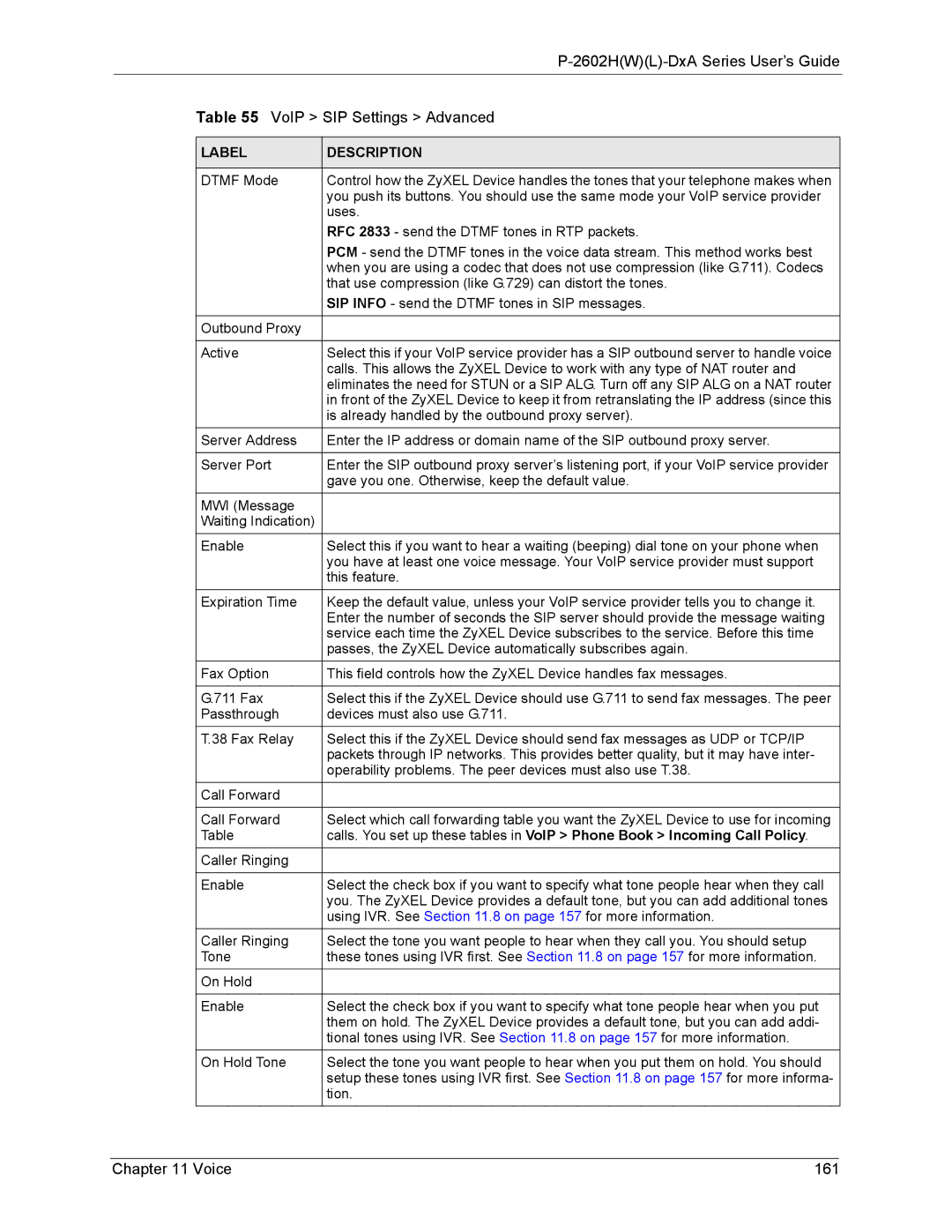|
|
|
| Table 55 VoIP > SIP Settings > Advanced | |
|
|
|
| LABEL | DESCRIPTION |
|
|
|
| DTMF Mode | Control how the ZyXEL Device handles the tones that your telephone makes when |
|
| you push its buttons. You should use the same mode your VoIP service provider |
|
| uses. |
|
| RFC 2833 - send the DTMF tones in RTP packets. |
|
| PCM - send the DTMF tones in the voice data stream. This method works best |
|
| when you are using a codec that does not use compression (like G.711). Codecs |
|
| that use compression (like G.729) can distort the tones. |
|
| SIP INFO - send the DTMF tones in SIP messages. |
|
|
|
| Outbound Proxy |
|
|
|
|
| Active | Select this if your VoIP service provider has a SIP outbound server to handle voice |
|
| calls. This allows the ZyXEL Device to work with any type of NAT router and |
|
| eliminates the need for STUN or a SIP ALG. Turn off any SIP ALG on a NAT router |
|
| in front of the ZyXEL Device to keep it from retranslating the IP address (since this |
|
| is already handled by the outbound proxy server). |
| Server Address | Enter the IP address or domain name of the SIP outbound proxy server. |
|
|
|
| Server Port | Enter the SIP outbound proxy server’s listening port, if your VoIP service provider |
|
| gave you one. Otherwise, keep the default value. |
| MWI (Message |
|
| Waiting Indication) |
|
| Enable | Select this if you want to hear a waiting (beeping) dial tone on your phone when |
|
| you have at least one voice message. Your VoIP service provider must support |
|
| this feature. |
| Expiration Time | Keep the default value, unless your VoIP service provider tells you to change it. |
|
| Enter the number of seconds the SIP server should provide the message waiting |
|
| service each time the ZyXEL Device subscribes to the service. Before this time |
|
| passes, the ZyXEL Device automatically subscribes again. |
| Fax Option | This field controls how the ZyXEL Device handles fax messages. |
|
|
|
| G.711 Fax | Select this if the ZyXEL Device should use G.711 to send fax messages. The peer |
| Passthrough | devices must also use G.711. |
| T.38 Fax Relay | Select this if the ZyXEL Device should send fax messages as UDP or TCP/IP |
|
| packets through IP networks. This provides better quality, but it may have inter- |
|
| operability problems. The peer devices must also use T.38. |
| Call Forward |
|
|
|
|
| Call Forward | Select which call forwarding table you want the ZyXEL Device to use for incoming |
| Table | calls. You set up these tables in VoIP > Phone Book > Incoming Call Policy. |
| Caller Ringing |
|
|
|
|
| Enable | Select the check box if you want to specify what tone people hear when they call |
|
| you. The ZyXEL Device provides a default tone, but you can add additional tones |
|
| using IVR. See Section 11.8 on page 157 for more information. |
| Caller Ringing | Select the tone you want people to hear when they call you. You should setup |
| Tone | these tones using IVR first. See Section 11.8 on page 157 for more information. |
| On Hold |
|
|
|
|
| Enable | Select the check box if you want to specify what tone people hear when you put |
|
| them on hold. The ZyXEL Device provides a default tone, but you can add addi- |
|
| tional tones using IVR. See Section 11.8 on page 157 for more information. |
| On Hold Tone | Select the tone you want people to hear when you put them on hold. You should |
|
| setup these tones using IVR first. See Section 11.8 on page 157 for more informa- |
|
| tion. |
Chapter 11 Voice | 161 |
